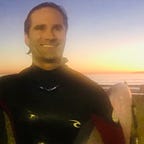The Zen of Jaco Pastorius
Typical Metal Stuff
It was cold and wet and windy by Southern California standards. A storm was rolling in, and what we referred to as “winter” was approaching at a leisurely West Coast pace.
I hopped on my BMX bike, slapped my Vans onto the pedals, and glided down the shiny wet black streets of my Orange County suburb. I had to make it across town to Tower Records and back before dark. That afternoon I had discovered the music that would change me forever, and I wouldn’t go to bed until I was holding the album in my hands.
Drums had been my first instrument, then I tinkered around with an old pawnshop electric guitar for a few months. But when I finally acquired my first bass, that was it. Afternoons and nights were spent doing one thing — practicing scales, arpeggios, and slap bass rudiments. I had started with some Black Sabbath songs, then graduated up the music hierarchy to more complicated pieces. Many weekends were spent putting the finishing touches on Cliff Burton’s (Metallica) groundbreaking, mind bending bass solos.
Like most musician kids of my generation, I worshiped guitar gods like Eddie Van Halen, Joe Satriani, and Steve Vai. My bedroom walls and ceiling were covered with Iron Maiden and Motley Crue posters — typical metal stuff. Until one day…
The Discovery
I had a bass instructor named Bill. He was a professional, gigging musician, which in my mind made him the coolest dude on the planet. Bill had always encouraged me to stick with music and to try to find work as a session player after high school.
One day I met Bill for my weekly lesson. He had brought a cassette tape and a walkman. Bill said: “All right dude, you’re ready to be exposed to Jaco and take your playing to the next level. Slap on these headphones.”
It was the most intricate music I’d ever heard. Jaco Pastorius’s 1976 debut solo album begins with a flawless rendition of Charlie Parker’s “Donna Lee,” played on a fretless electric bass accompanied by conga drums. Nothing more. Jaco’s opening salvo remains timeless and immortal more than 40 years after its release. The remaining tracks on the album consist of gnarly funk grooves (“Come On, Come Over”), hypnotizing bass harmonics seemingly invented by Jaco (“Continuum”), haunting and complex string arrangements (“Forgotten Love”), and the most beautiful piece of music I have ever heard, “Portrait of Tracy.”
Jaco’s later work with Weather Report was amazing too, but his 1976 debut is widely acknowledged as the greatest bass album of all time.
Inspired
I dedicated the next two years to dissecting Jaco’s debut album and learning as many of the arrangements as I could, slowly limping through each track one note at a time. I had a high school buddy who also played bass, and I turned him onto Jaco. You have to check out this bass player, he jams like a mofo! We traded notes on one of Jaco’s masterpiece tracks with Weather Report (“Teen Town”), and I strutted with a great sense of pride when I could finally keep up note for note. My silver Fender bass went everywhere with me and I could not a bear to live a single day without playing.
I happened upon a copy of Jaco’s “Modern Electric Bass” instructional video when I was about 16. On that video, Jaco’s rendition of “America the Beautiful,” accompanied by John Scofield on guitar and Kenwood Dennard on drums, was explosive and emotional. At the end of that session, Jaco unstrapped his bass and tossed it at the stunned drummer, who nearly fell off his stool trying to catch the bass in midair. Badass!
Gateway To Jazz
Jaco’s influence on the bass playing community was undeniable. Throughout the 1980s, there was a bottomless pit of Jaco copycats trying to mimic his staccato style and harmonic techniques. Go back and listen to Top 40 music from the 1980s, and you’ll notice a whole lot of fretless bass playing where it doesn’t belong. The better players learned to cultivate their own style, but too many professionals seemed unable to resist the urge to ride Jaco’s coattails.
I was lucky to have discovered Jaco’s music as a teenager. The music from that debut album helped me to appreciate world music and eventually led to my love of other jazz greats like Bill Evans, Oscar Peterson, and John Coltrane. Without Jaco’s introduction to jazz, I would have probably spent the remainder of my days wandering the earth somewhat lost musically.
Legacy
It is difficult to put one’s finger on the Zen of Jaco’s playing. Sure, he was fast and sometimes flashy and played solos like a prodigy. But that was not really his allure. There was something magical and cosmic about Jaco’s timing, feel, and sense of space with the other players. He had a way of locking in musically with drummers especially, making the bass and drums sound like one instrument. The warm tone that he pried from an unassuming Fender Jazz Bass remains the stuff of legends. Equally breathtaking was Jaco’s ability as a composer (“Three Views of a Secret”). It was as if Jaco’s music was born in his heart, flooded through his hands, then shot like lightening into his bass.
Jaco’s life was tragically taken much too soon, but his lasting influence on the music community is immeasurable. As a metal kid from the 1980s, Jaco’s music was my gateway to jazz and the inspiration that floated me into adulthood.
J.S. Lender’s new book They Are Here Now (Short Tales) is available in paperback on Amazon.
